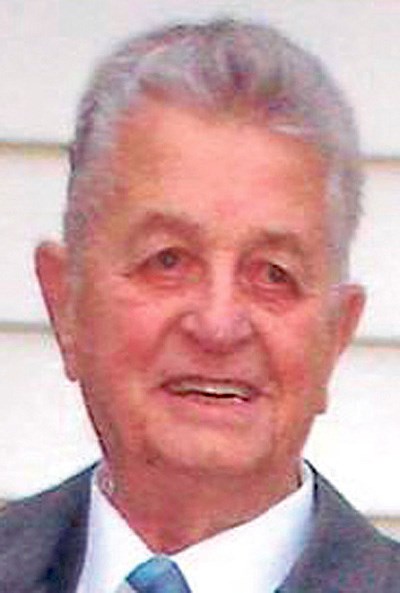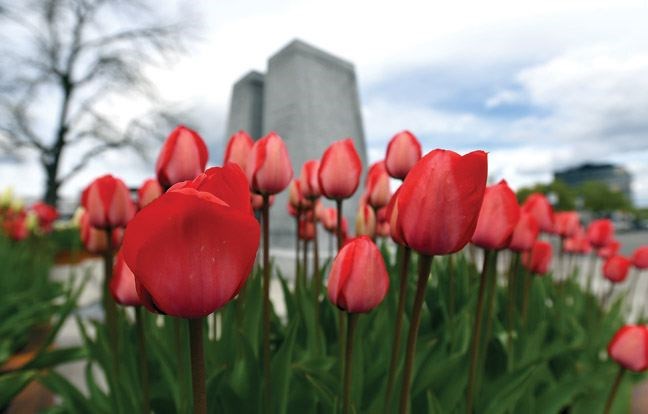When one area resident thinks of Canadians, he's not only grateful for their part in liberating Holland from German occupation on May 5, 1945, but for those at the Canadian embassy that actually believed the city boy was a farmer when he boldly lied so he could immigrate in pursuit of a better life.
Theophiles Dumhof, better known as Ted, 89, has lived in Vanderhoof for decades.
The journey to get to Canada was horrific, leaving him still waking during the night to the recollected scent of burning flesh.
In 1940, when Dumhof was 12, he lived in Rotterdam, Holland in the Netherlands.
"That's when the Germans came and bombed the whole city," Dumhof said. "Our house was bombed and my mom and dad went to Paris and their two boys - me and my brother John - went to a school in the southern part of the Netherlands. There were 600 boys down there and the brothers of the Catholic faith looked after us."
Not long after, the Germans came and took the boys in trucks to Amsterdam.
"In Amsterdam we waited until they had a trainload full and they took us to Braunschweig, Germany," Dumhof said.
At that time Dumhof and his brother John, who was one year older, were separated.
John survived but Dumhof didn't know that until years later.
When Dumhof arrived at Braunschweig, he and some of the other boys were brought to work at a bomb-making factory. He later found out those bombs were dropped on England during the Second World War.

"The allied forces came and they bombed Braunschweig flat," Dumhof said. "There wasn't a stone left standing one on top of the other. We were way down in a bunker and we came out and they said we had to get in a forced march to Auschwitz, Poland. When people lagged behind they would just shoot them and left them laying in the ditches."
The trains came from the West, they came from the East, Dumhof recalled.
"The younger girls up to 23, 24, they sent them in trucks to the troops on the front for pleasure girls and the rest they said you need to take a shower but instead of a shower they gassed them. So we took them out when they were dead and we knocked the gold teeth out, took their necklaces and their watches and put them in a box, and the dead bodies we put them on lorries and we took them to the ovens and there they burned them."
It was slave labour, Dumhof said.
"You had to do it otherwise they would just shoot you."
Dumhof just did what he had to do to survive.
"Life is life and I really just did my best to stay alive," Dumhof said.
The labourers at the concentration camp barely survived because there was no food.
"We ate rats, cats and dogs, everything we could get - we ate grass and raw potatoes - anything to keep our stomachs full," Dumhof said. "There were people dying there every day. It was very bad. We just lay in the straw beds and I really didn't ever make it to work again because the Russians picked me up from my bed and took me to the field hospital."
The Russians liberated the labourers from Auschwitz in 1945, he added.
Dumhof was taken to a hospital where he made a slow recovery from the effects of starving for so long. He spent three months in a field hospital eating soup because his stomach was so damaged.
"So then they delivered us to the American forces who took us back to Holland," Dumhof said. "My mom and dad had come back to Rotterdam and that's where we lived."
Dumhof, thinking life would get back to normal, went to school for two years to be a goldsmith. He was then drafted by the Dutch government into the Netherlands Forces Intelligence Service (NEFIS).
"So I had to go," said Dumohf, who ended up in Indonesia jungle fighting after two months of training. "I landed in Samarang and we fought the Japanese there for three and a half years. We never saw the sun because in Indonesia it's very hot and we were always under the canopy of trees."
Dumhof remembers being dropped off behind the lines and with machetes would cut through the jungle.
"We went with 1,600 men in the NEFIS and we came back with 160," Dumhof said.
After three and a half years, Dumhof returned to Holland and he was paid $1,000 for his trouble.
He returned to school again and soon after he got another draft notice to fight the North Koreans, he said.
"I thought to myself, that was enough," Dumhof said. "So I went to the Canadian embassy and I went to the left-hand side and there was a lady sitting there and I said 'my name is Ted Dumhof and I would like to immigrate to Canada and I'm a jeweler. Do you need jewelers?'"
She said no, they needed farmers.
"So three days later I went to the man on the right-hand side," he said. "I had bought a cap and put some farmer clothes on and rubber boots and I went to the man and I said 'I'd like to immigrate to Canada. My name is Ted Dumhof and I'm a farmer'"
Three days later, he was on his way to Canada. He was sent to Kindersley, Saskatchewan.
Dumhof was sponsored by a farmer who had seven daughters and needed help on the farm.
"I slept with the horses," Dumhof laughed. "I slept in the straw and when I stepped out of my bed I disappeared in about two feet of horse dreck. My dad was a banker - I came from a feather bed to horse dreck."
The farmer was very good to Dumhof and he stayed there for three years.
"He was very patient," he added. "I never saw a horse but from 10 feet away, but I persevered and saw how everyone else did it and I had one heck of a time."
He managed to do all the farming duties assigned to him.
After that, he moved to Saskatoon where he became a goldsmith and when he was told the jewelry store needed a traveling salesman, he took on the challenge. Later he turned to selling Delft Blue pottery house-to-house and that's when he met his wife, Lokadia. Their first date was skating at the ice rink.
"She fell down so I picked her up and put my arm around her middle so we skated around and we held hands for six months and then we got married," Dumhof said, who continued to be a traveling salesman.
He was going through Vanderhoof, population 900, when one of the men in town told him he was working too hard and took him fishing. That's all it took for Dumhof to realize what a nice place he was in and he bought the jewelry store in town.
He helped make a success of it by doing goldsmithing for the jewelry stores in Prince George, he added.
The Vanderhoof store was called Ted's Jewelry and he had another store in Smithers.
"After 25 years I thought that was enough and at 50 I retired," said Dumhof.
He and Lokadia took the time to travel the world.
"Life was good then," said Dumhof.
Unfortunately, in 2003, she died unexpectedly.
As a result of losing his beloved wife, Dumhof sold their house and the business and continued on his travels.
Now he lives in an apartment complex for seniors in Vanderhoof.
"Life goes on," said Dumhof. "And these days it's all together different than what I've seen, let me tell you."
Dumhof wanted to attend the Dutch Canadian Tulip Commemoration at noon today at Veterans' Plaza in front of city hall in Prince George but he long ago arranged an extended trip to Mexico where he is right now.
The tulip is a symbol of gratitude the Dutch have for Canada to show appreciation to the soldiers who liberated Holland from German occupation in 1945. To honour this event the Dutch continue to send 10,000 tulips to Canada and now Ottawa has more tulips than any other place outside the Netherlands.
The local tulip commemoration event takes place annually with the cooperation of the City of Prince George.



